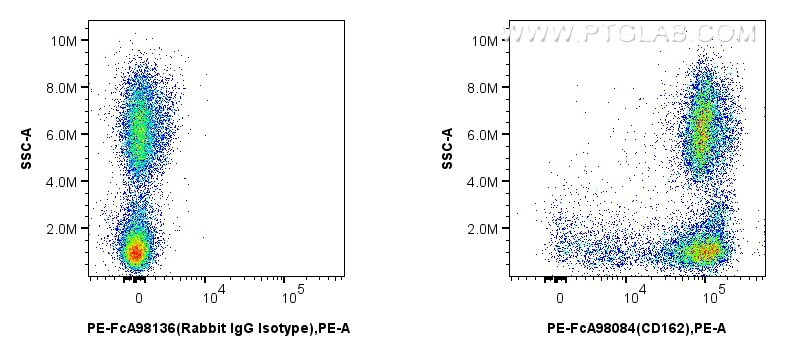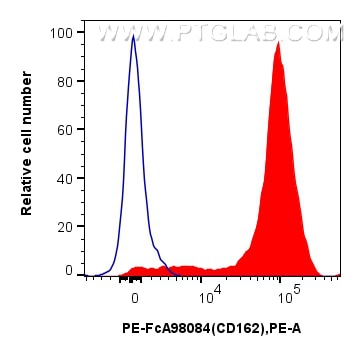Tested Applications
| Positive FC detected in | human peripheral blood leukocytes |
Recommended dilution
| Application | Dilution |
|---|---|
| Flow Cytometry (FC) | FC : 5 ul per 10^6 cells in 100 μl suspension |
| This reagent has been pre-titrated and tested for flow cytometric analysis. The suggested use of this reagent is 5 ul per 10^6 cells in a 100 µl suspension or 5 ul per 100 µl of whole blood. | |
| Sample-dependent, Check data in validation data gallery. | |
Product Information
PE-FcA98084 targets SELPLG/CD162 in FC applications and shows reactivity with human samples.
| Tested Reactivity | human |
| Host / Isotype | Rabbit / IgG |
| Class | Recombinant |
| Type | Antibody |
| Immunogen | Recombinant Protein Predict reactive species |
| Full Name | selectin P ligand |
| Calculated Molecular Weight | 412 aa, 43 kDa |
| GenBank Accession Number | BC029782 |
| Gene Symbol | SELPLG |
| Gene ID (NCBI) | 6404 |
| Conjugate | PE Fluorescent Dye |
| Excitation/Emission Maxima Wavelengths | 496 nm, 565 nm / 578 nm |
| Form | Liquid |
| Purification Method | Protein A purification |
| UNIPROT ID | Q14242 |
| Storage Buffer | PBS with 0.09% sodium azide and 0.5% BSA, pH 7.3. |
| Storage Conditions | Store at 2-8°C. Avoid exposure to light. Stable for one year after shipment. |
Background Information
SELPLG (selectin P ligand), also known as CD162 or PSGL-1, is a 120 kDa type I transmembrane mucin-like glycoprotein. It is an adhesion molecule expressed on the surface of neutrophils, monocytes, and most lymphocytes as a homodimer of approximately 230-250 kDa (PMID: 7545173; 1378449; 9353350). SELPLG plays a critical role in the early stages of inflammation due to its ability to bind E-selectin (CD62E), L-selectin (CD62L), and P-selectin (CD62P) (PMID: 35597982).
Protocols
| Product Specific Protocols | |
|---|---|
| FC protocol for PE SELPLG/CD162 antibody PE-FcA98084 | Download protocol |
| Standard Protocols | |
|---|---|
| Click here to view our Standard Protocols |





